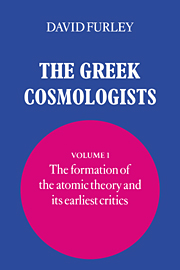Book contents
- Frontmatter
- Contents
- Preface
- 1 Two pictures of the world
- 2 The judgement of Socrates
- 3 The beginning in Miletus
- 4 Two philosophical critics: Heraclitus and Parmenides
- 5 Pythagoras, Parmenides, and later cosmology
- 6 Anaxagoras
- 7 Empedocles and the invention of elements
- 8 Later Eleatic critics
- 9 Leucippus and Democritus
- 10 The cosmos of the Atomists
- 11 The anthropology of the Atomists
- 12 Plato's criticisms of the materialists
- 13 Aristotle's criticisms of the materialists
- Bibliography
- Index of passages
- General index
1 - Two pictures of the world
Published online by Cambridge University Press: 27 January 2010
- Frontmatter
- Contents
- Preface
- 1 Two pictures of the world
- 2 The judgement of Socrates
- 3 The beginning in Miletus
- 4 Two philosophical critics: Heraclitus and Parmenides
- 5 Pythagoras, Parmenides, and later cosmology
- 6 Anaxagoras
- 7 Empedocles and the invention of elements
- 8 Later Eleatic critics
- 9 Leucippus and Democritus
- 10 The cosmos of the Atomists
- 11 The anthropology of the Atomists
- 12 Plato's criticisms of the materialists
- 13 Aristotle's criticisms of the materialists
- Bibliography
- Index of passages
- General index
Summary
The educational tradition of the Western half of the world has fairly recently adopted a new picture of the physical universe and man's place in it. We are now brought up to believe that we live on one of the planets that move in orbits around a rather minor star, itself a member of one galaxy among a vast number of others. We are taught that our planet is not eternal, but had an origin and will have an end; that it has grown into its present condition through a long evolutionary process, in which the minerals developed first, before any life appeared, and then the complex living species that we see around us, including man, evolved over a very long period of time through the processes of mutation, natural selection, and inheritance.
This picture has largely, though not entirely, replaced an earlier one that held the field for many centuries. According to that, the earth is stationary at the center of the cosmos. The stars, planets, sun, and moon revolve around the earth. The cosmos is finite, being bounded by the outermost sphere of the heavens, and is unique. This cosmic order, according to the prevalent, Judaeo-Christian version of the picture, was determined and brought into being at a certain point of time by God, who adopted it because it is a good order. He also created all the living species that now exist and arranged them in a hierarchical order of decreasing complexity or excellence, with man at the top of the scale.
- Type
- Chapter
- Information
- The Greek Cosmologists , pp. 1 - 8Publisher: Cambridge University PressPrint publication year: 1987

